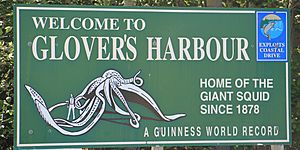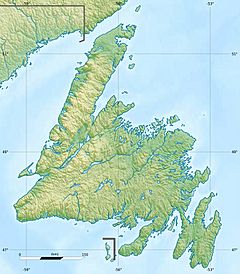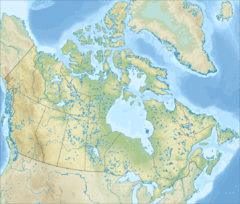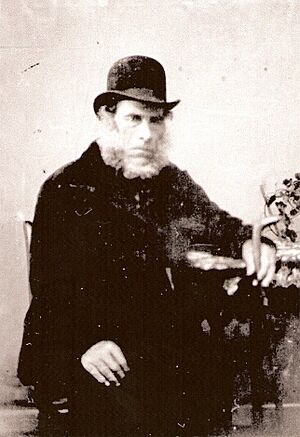Glovers Harbour, Newfoundland and Labrador facts for kids
Quick facts for kids
Glovers Harbour
Thimble Tickle
|
|
|---|---|
|
Designated place
|
|

Welcome sign referencing the giant squid specimen of 1878 and its recognition by Guinness World Records
|
|
| Country | |
| Province | |
| Electoral district | Coast of Bays–Central–Notre Dame (federal) Exploits (provincial) |
| Census division | 8 (subdivision E) |
| Settled | late 1800s (≤1878) |
| Founded by | Joseph Martin |
| Named for | John Hawley Glover |
| Area | |
| • Total | 8.85 km2 (3.42 sq mi) |
| Elevation | 0–20 m (0–66 ft) |
| Population
(2016 census)
|
|
| • Total | 92 |
| • Density | 10.4/km2 (27/sq mi) |
| Time zone | UTC−03:30 (NST) |
| • Summer (DST) | UTC−02:30 (NDT) |
| Postal code |
A0H 1E0
|
| Area code | 709 (COC: 483) |
| NTS map no. | 002E06 |
| GNBC code | AAIAE |
| Highways | |
Glovers Harbour ( GLOH-verz) is a small coastal community in Newfoundland, Canada. It is located in Notre Dame Bay on the northern coast. This quiet place is mostly known for a very special event that happened there in 1878. A huge giant squid was found on its shores! This amazing discovery was even recognized as a world record by Guinness World Records. Today, Glovers Harbour proudly calls itself the "home of the giant squid." It has a small heritage center and a life-sized sculpture of the squid, which are its main attractions for visitors.
Contents
Exploring Glovers Harbour's Name and Location
Glovers Harbour got its name from John Hawley Glover. He was the Governor of Newfoundland for a few years in the late 1800s. There's even a spot on the southern shore called Glovers Point.
What is a "Tickle"?
Glovers Harbour used to be called Thimble Tickle(s). In Newfoundland English, a tickle is a narrow strait. Think of it as a small, narrow channel of water between islands or land. The name Thimble Tickle was used for several nearby water features and land points.
There was also a copper and sulfur mine nearby called Thimble Tickle Prospect. It operated on and off in the 1880s and 1890s.
A Look at Glovers Harbour's Past
How Glovers Harbour Began
Local stories say that Glovers Harbour was started by Joseph Martin. He moved there in the late 1800s. His daughter married into the Marsh family, who were the first settlers of nearby Winter House Cove. These two families were the main residents for a long time.
Glovers Harbour first appeared in the Canadian census in 1901. Back then, it was called Glover Harbor and had 67 people. By 1921, the population dropped to just 11 people. But it slowly grew again, reaching 38 by 1945.
Changes During Resettlement
For many years, fishing for cod was the main way people made a living. They also did some logging and farming. But it was hard to get around because there were no good roads.
In 1962, a road was built connecting Glovers Harbour to Route 350. This was a huge change! It made it easier to reach bigger towns like Botwood and fish markets in Leading Tickles.
Around this time, the Newfoundland government had a "resettlement program." This program encouraged people from very isolated communities to move to larger, more connected places. Many families from nearby Lockesporte and Winter House Cove moved to Glovers Harbour because their own communities didn't have road access.
This caused Glovers Harbour's population to grow a lot. Between 1966 and 1971, the number of people living there almost tripled, going from 52 to 145!

Because of these moves, Glovers Harbour became a community where most people belonged to The Salvation Army. The village built its first Salvation Army church, which also served as a school. Later, another church was built.
An Anglican church from Winter House Cove was even floated across the water to Glovers Harbour! It was used as a school until the late 1960s. After that, students traveled by school bus to elementary school in Leading Tickles and high school in Point Leamington.
After its population peak, Glovers Harbour's numbers slowly decreased over the next few decades.
Glovers Harbour Today
In 2016, Glovers Harbour had 92 residents. Fishing is still important, but now people also catch lobster, capelin, squid, and snow crab.
There's also a plan to make the coastal area around Glovers Harbour a Marine Protected Area (MPA). This would help protect the ocean and its creatures.
The Famous Giant Squid
Glovers Harbour is most famous for its connection to the giant squid (Architeuthis dux).
The Thimble Tickle Specimen
On November 2, 1878, an incredible event happened. A live giant squid, said to be about 55 feet (17 meters) long, was found stuck near the shore. Fishermen used a grapnel and rope to tie it to a tree so it wouldn't float away. The squid died as the tide went out.
Sadly, no parts of the squid were saved, and there are no photos or exact measurements. The squid was cut up for dog food soon after it was found. We only know about it from a letter written by Reverend Moses Harvey in 1879. He described the amazing scene:
The fishermen saw a huge object in the water. They thought it was part of a shipwreck, but as they got closer, they saw it was a giant fish with huge, glassy eyes. It was trying to escape, splashing the water with its huge arms and tail. It was stuck, and the tide was going out. It was shooting out water from its funnel, which is how squids move backward. Sometimes the water was black like ink!
The fishermen were brave and threw their grapnel, which stuck into the squid's soft body. They tied a strong rope to the grapnel and then to a tree on shore. The squid was stuck! It struggled terribly, throwing its ten arms around. The fishermen stayed far away from its long tentacles. Finally, it got tired and died as the water went out.
The fishermen, not knowing how important it was, turned it into dog meat. It was a magnificent specimen—the largest ever caught. Its body was 20 feet (6 meters) long from its beak to the end of its tail. One of its arms was 35 feet (11 meters) long! This must have been a feeding tentacle.
While the original story only mentions Stephen Sherring and two other fishermen, later stories say that Joseph Martin, who founded Glovers Harbour, was one of them. George Marsh and Henry Rowsell, who founded nearby communities, have also been mentioned as participants.
This "Thimble Tickle specimen" has been recognized by Guinness World Records as the largest giant squid ever recorded. However, the reported measurements, especially the 55-foot total length, are much larger than any scientifically proven giant squid. Scientists now think these lengths might have been exaggerated. This could be because the long feeding tentacles were stretched, or the measurements weren't taken perfectly.





